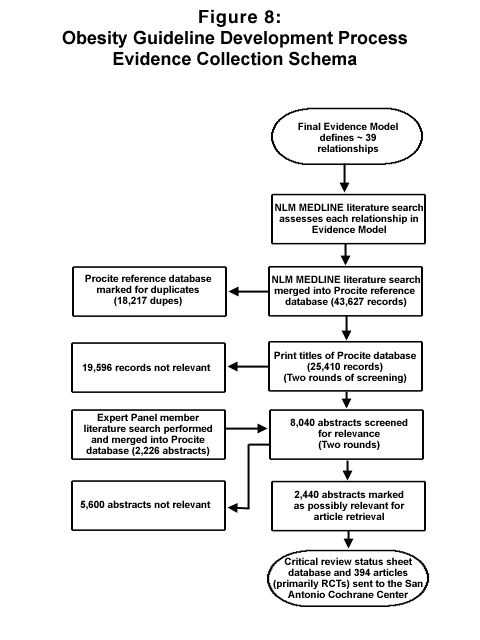 |
Home ·
Resources ·
Search ·
Textbook Map ·
OEI Home ·
NHLBI Home
Guidelines on Overweight and Obesity: Electronic Textbook |
||||||
Panel Selection ·
Topics Included in the Guidelines
· Development of the Evidence
Model · Search and Review of the
Literature · Literature
Abstraction and Preparation of Evidence Tables ·
The Formulation of the Evidence into
the Guidelines · Consideration of Special Populations and Situations
· External Review of the
Guidelines · Caveats to
Recommendation Use
|
|||||||
| 1.d. Search and Review of the Literature The literature was searched and systematically reviewed by
The panel decided on the parameters for the literature search, particularly for the search dealing with the model linking treatment to weight loss. The parameters of the search included year of publication, country, language, study design, length of the study, outcome measures (which, what, and when), and patient characteristics (age and weight). The panel decided to limit its search to English-language studies, but included foreign studies that provide an English abstract and are randomized controlled clinical trials. The search included human studies only published in MEDLINE from January 1980 to September 1997. No editorials, letters, or case reports were accepted. The panel was aware that two books published in the early 1980s coded the bulk of the obesity literature written to that point. Panel staff and librarians at the National Library of Medicine's National Information Center for Health Services Research determined the medical subject heading terms used in the literature review. The number of citations found by topic area is provided in Appendix I.A.2. Figure 8 illustrates the various steps used to collect the evidence. Of the 43,627 titles acquired from the MEDLINE search, 18,217 were duplicates, leaving 25,410 titles to be considered. Using the ProCite reference database, the 25,410 titles were screened by two reviewers and ultimately marked for their appropriateness. Abstracts for the appropriate 8,040 remaining titles were then screened for relevance in two rounds. Two individuals independently reviewed each abstract using the inclusion and exclusion criteria developed by the panel. A third reviewer would sporadically check the quality of the screening. This review led to 2,440 possibly relevant abstracts. Due to the greater quality of the evidence, the decision was made that randomized controlled trials pertinent to the treatment portion of the model be the top priority for data abstraction. Ultimately, 394 articles of randomized controlled trials were reviewed for data abstraction. |
